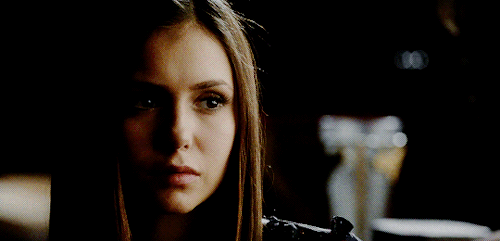#alice in neverland
Reaching Paradise
I am terribly sorry for the inactivity, life has been very hectic! I do want to get back on answering asks, but I wanted to just share thoughts on chapter 136 first, if a bit belatedly.

The chapter cover is very clearly a reference to Alice growing giant in the White Rabbit’s house. Emma is even standing in what looks very similar to a rabbit hole.
I have discussed this with @ , and I hope that the inclusion of the Anna and Nat chibis are a foreshadowing to them having an important part later on.
I have said in a post before that Norman doesn’t stand a chance against Son-ju unless he gets information about his abilities, and a chance to make a plan against him, and Norman must know this. This is why I think Don and Gilda are wrong to assume Norman sent Aishe with them to kill Son-ju…
I think Norman’s plan is to have Aishe gather information on Son-ju, so she will be acting harmless and supportive. What Norman needs the most is info on Son-ju’s fighting ability, so I think there is a good chance either him or Aishe will provoke a situation where Son-ju has to fight, but rather than fighting against him, she would fight alongside him and observe.
Also note the white birds on the cover, I think they are meant as references to doves, which are representation of the holy spirit and pentecost. Interestingly; we do have spirits appear later in the chapter…
Speaking of Alice in Wonderland references, I did miss a couple, like the time when Alice as a giant, knocked over the jury-box filled with a load of animals, which looked just like the animal toys Emma and Ray stumbled into:

Or just the confusing signs navigating her in essentially a maze in Wonderland, which we know Emma and Ray also experiences…

But speaking of references, it is made clear this chapter that I was absolutely right to draw a parallel with The lion the witch and the wardrobe. In that novel, just like in TPM, the wardrobe is a portal to entirely different worlds of existence.

I wonder if we will see more of the lion, since we did see a lion plushie in that extra sketch with Shirai-san being sick.
Speaking of references, I am increasingly sure that the Dante’s Divine Comedy parallels are real.

Purgatory is full of lost souls who wander for eons in order to purify themselves of their sins and get to Paradise.
(Tbh, the soul theme is also fitting for Pentecost, a holiday celebrating the Holy Spirit…)
Once Dante reaches the 7th terrace of Purgatory, he is finally purified, by having to walk through fire. He can then enter the Earthly Paradise, the same one that Adam and Eve were banished from.
Interestingly, every time that a soul completed the trials of Purgatory, the mountain shook with an earthquake… that makes me think of this part of the 7 walls riddle:

The earth screaming and an earthquake sound at least vaguely similar, right?
Inside the Earthly Paradise, Dante encounters Beatrice, who he had believed lost until then, which again is vaguely familiar of Ray believing Emma lost, but then encountering her again at the end.
Then Beatrice tells Dante to look into the sun, and after he stares into it, he starts to see two suns instead of one, and his body becomes so light, he starts to fly to heaven to meet with God, along with Beatrice.

I have mentioned it before that I suspected this cover to reference Dante’s flight through Heaven, but I actually think that him gazing into the sun is the solution to a part of the Seven Walls riddle…
Ray says that the “when the sun sets in the East” is a reference to reversing time, since the sun rises in the East and sets in the West, so only if you reverse that will you get the “sun setting in the East”.
But I think there is another solution: if you mirror the setting sun, the mirror image will set in the East, while the original sets in the West. Mirrors had been a theme in the series, but perhaps they don’t have to physically use a mirror….
The condition may already be met if they trick their brains by staring into the sun for a moment, then turning East. If you stare into the sun, you will see an afterimage afterwards, perhaps creating an illusion of the sun setting in the East. This is easily doable, unlike Ray’s idea of reversing time, which humans can’t normally do.

Ray also assumes that the arrow stopping in the sand signifies time stopping. But what about a simpler interpretation? Until they entered the desert area, arrows kept constantly appearing, but once they stepped out onto sand, the arrows have stopped (appearing). So could they have already met that condition?


I wonder if Ray’s assumption on what the seven walls are is really accurate. Emma questions it, since the way the riddle is phrased, it is implied that the Seven Walls haven’t appeared yet, and they will be an obstacle to pass once the rest of the riddle is solved.
But perhaps it just means that they had to figure out the bit about the time and space to be able to progress into the next part, the desert land, which is Purgatory’s analogy.
What I find a fascinating parallel though is that squiggly demon!God is described as existing outside of time and space. This is exactly how the Empyrean, the dwelling place of God in Dante’s Divine Comedy is described as well. So I think this is another possible analogy.
I have ran out of images, but I also loved the new cover extra with the rain and umbrellas. It really looks like each child is in a bubble, protected underwater! Can’t wait to see the significance of rain in the actual manga, that has been foreshadowed before too. We must be close.
Also, note that the first “planet” that Dante visits is the Moon, which has also been foreshadowed to have a significance…
I wanted to do a proper post on chapter 134 and explain some of the imagery that may at first have looked confusing or shocking. This post took forever to make just because of IRL commitments coming up! I will also get back to answering asks asap, sorry, I feel bad for taking so long on them!
I have posted previously about a long list of Bible references in TPN, from Genesis, to Exodus and the New Testament. If you haven’t checked those yet, you can look in my “Neverland Mythology” page for a list of posts (if you can’t find it on the phone, try it on a desktop browser).
So as soon as I saw the spoilers of Ray wandering a desert for a long time, I instantly picked up on the imagery resembling the aimless wandering in Exodus. I also noticed that Ray’s hand looked wrinkled, and his hair looked like it could be streaked with grey.
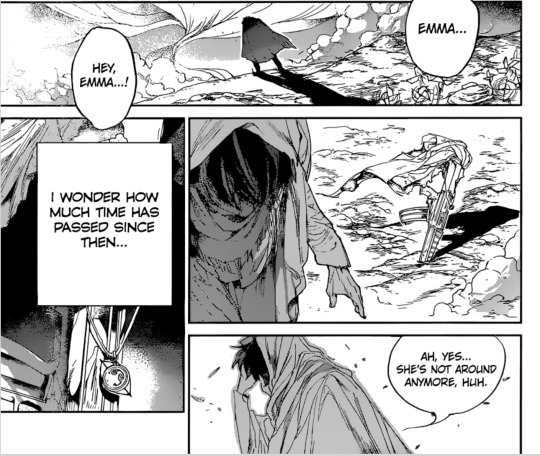
So while others expected to see a young adult Ray, I wasn’t surprised when we got this instead:

After all in Exodus we did have someone wandering the desert aimlessly for decades in search of the PROMISEd land…
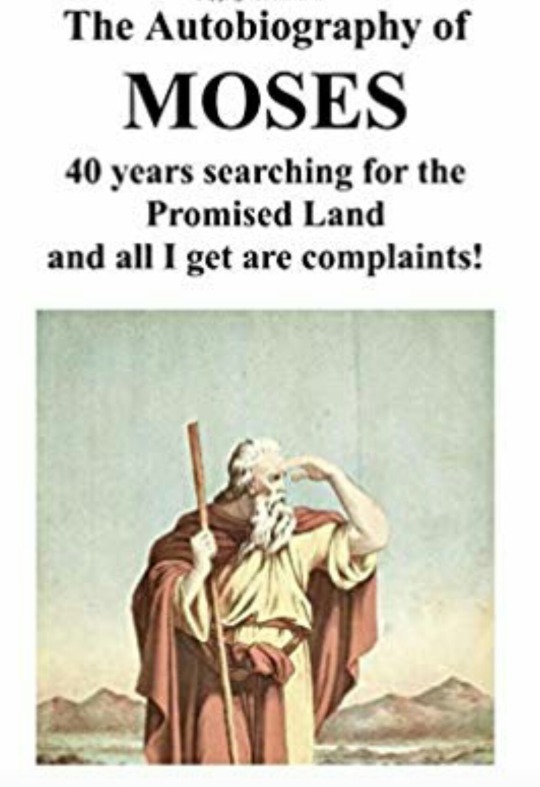
In fact I did joke that Ray may look like a 53-year-old (13+40 years in the desert like Moses) before I saw his face, and indeed he does appear like he could be in his 50s…
Here is a little more on Moses from wikipedia:
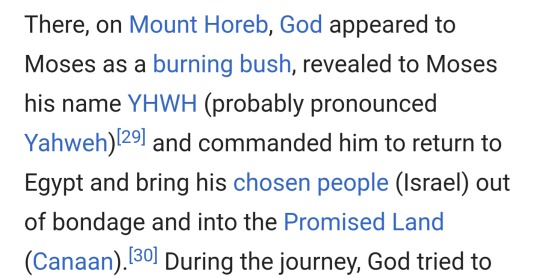
I find it interesting that God’s name is also unreadable, just like squiggly named demon!God… We haven’t seen a burning bush yet, I wonder if we will though in the future.
Another point about Moses’ story in Exodus is how he parted the Red Sea.
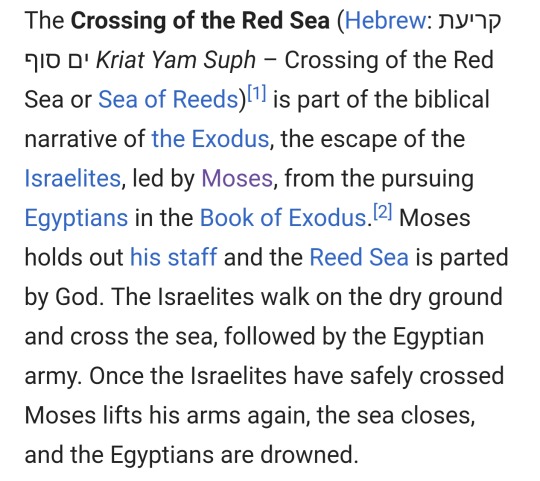
Since I have my theory that the demon world is located deep under the sea, a Red Sea reference would fit very well with that. So perhaps we will see either Ray or Emma part the ocean to get to the squiggly named demon!God? Recently we did see some Emma art with a staff. Also, notice that her robe has a lining with David’s stars? That’s a jewish symbol, and Moses’ story is about the jews. There are other stars as well on the outfit, as well as astrology symbols and constellations, but those perhaps could be related to reaching the heaven and the sphere of stars in Dante’s Divine Comedy, if my theory on that is right.

Something else to consider for the place of day and night is the beginning of Genesis, where God created the world in 7 days… Some of these illustrations of the separations of day and night, air and ocean remind me of images of where the demon!God is. Perhaps this could be related to the Seven Walls if the Seven Seas is not what they are?

Okay, but what about Pentecost? Why did I say there were references to it this chapter? For those of you, who are not aware, Pentecost is a Christian holiday 40 days after Easter, it is a moving holiday just like Easter. The earliest possible date for it is May 10th (when the early release of chapter 134 happened), and the latest date for it is June 13th.
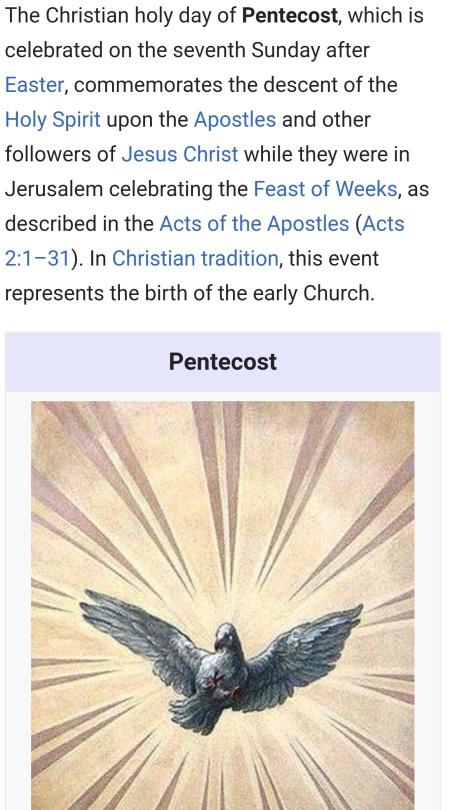
One of the main symbols of Pentecost is the dove, we saw two tiny doves hidden this chapter:
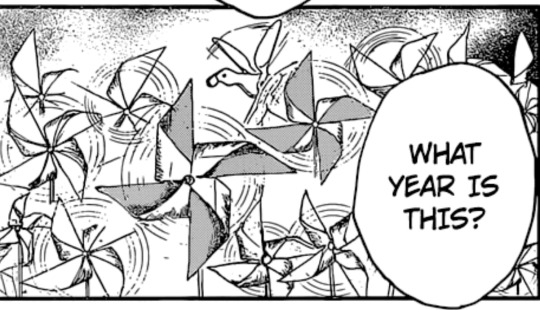
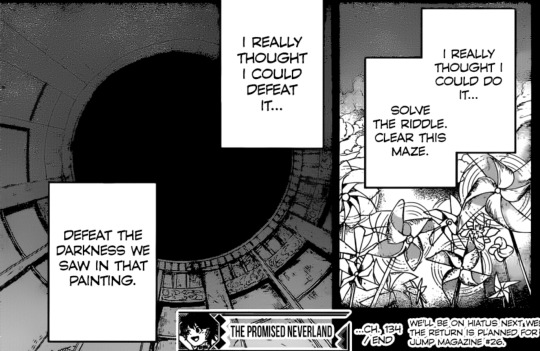
But you know what is significant about the pinwheels? They are another commonly used icon of Pentecost, specifically for children, to teach them about the Holy Spirit. In the Bible, the descent of the holy spirit was associated with strong winds, and it is advised that by observing how the pinwheels whirl, the children can be taught how just like the wind (and the holy spirit) there are things that are there even when you can’t see them.
There is another traditional symbol of Pentecost:
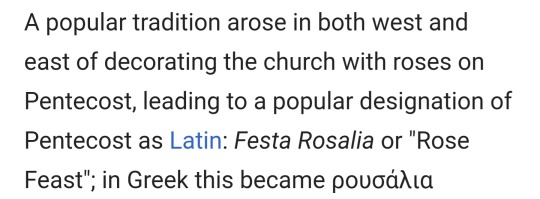
This chapter we actually see a flower on the table, and unlike the vida flower which is made of many small flowerheads, it has one big flower, just like a rose.
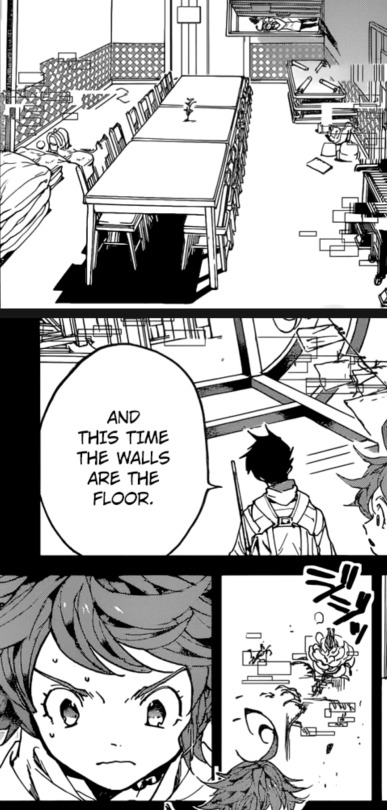
Pentecost actually ties to both Genesis and Moses as well:

I have said this before, but I believe that the original Promise is an analogy of the Old Testament, or the old promise between God and people (jews at the time), which was established by the 10 commandments being received by Moses. Why is this significant? Well Pentecost celebrates the establishment of the christian church, built on the New Testament, or the new promise between God and people… read this analysis also from wikipedia.

So if my analogy is right, it would make sense that as Emma is trying to set up a Second Promise, or a new covenant, Shirai-san would reference the celebration associated with it.
Finally, the part about the maze reminds me of Alice in Wonderland…
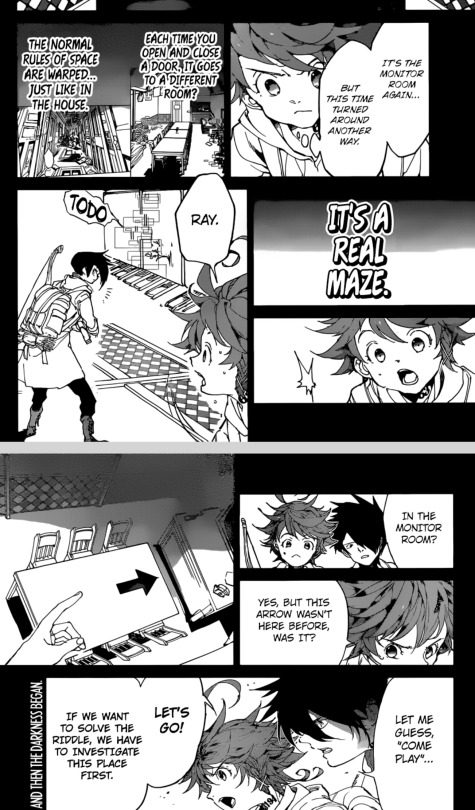
When searching to leave Wonderland, Alice is guided by the Cheshire Cat to meet the Queen of Hearts, and comes into her strange garden, which is a labyrinth.

Lewis Carroll (famous for writing Alice in Wonderland) was a mathematician. When he was in his twenties he drew a very tricky maze with paths that crossed under and over each other.
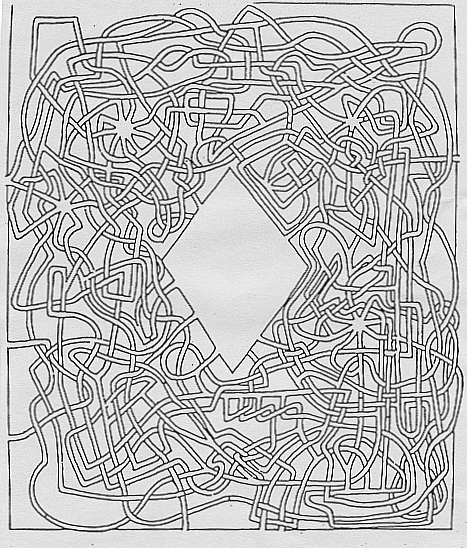
Interestingly, Robert Abbott, a game designer has also created a set of logic mazes he called the Alice Mazes, and it is based on following arrows, just like what Emma and Ray sees.

You start at the red square, and follow the arrows to reach the goal. These start out deceptively simple, but can get incredibly complex. Some have 60 or more moves, any one of which can send you down the wrong path. You can search for these online and play them.
He says on his website: “ these are called “Alice” mazes because they recall the scene in Alice in Wonderland where Alice eats a piece of cake with the sign “Eat Me” and grows larger, then she drinks from a bottle marked “Drink Me” and becomes smaller. These mazes won’t make you larger or smaller, but the distance you travel in a move will get larger or smaller.”
The Seven Walls’ cryptic message is all about travelling distances as well.
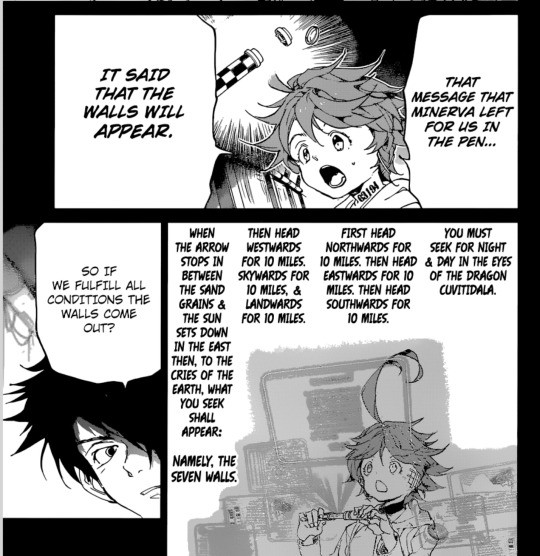
There is a popular puzzle game that could have some significance, since we have seen Posuka-sensei highlight a related animal in important art pieces:

Snakes and ladder is actually a very ancient game, that has been popular for a long time. If you have played it, you will know that it deals heavily with the frustration of ending back where you started. Could Emma and Ray be playing a giant game of Snakes and Ladders?
Well, hopefully the new chapter will be out soon and we will know more!


